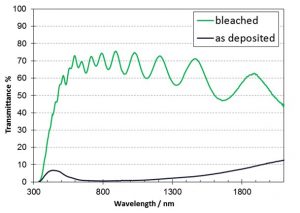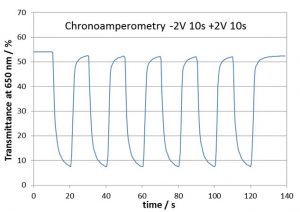Contact: Dr Andreas Schüler, Olivia Bouvard
The use of windows with switchable solar heat gains limits the cooling needs in summer, and decreases the heating needs in winter. The use of inorganic solid-state ion conductors such as LiPON, LLTO and Ta2O5 open the pathway to more durable devices, which can be built-up as multilayered film stacks on one glass substrate.
For highly glazed office buildings, even in Switzerland a form of solar protection is needed in order to avoid excessive cooling needs and to provide thermal and visual comfort. The use of windows with switchable solar heat gains limits the cooling needs in summer, and decreases the heating needs in winter.
Even though smart windows based on electrochromic coatings are on the market today, there are still several major drawbacks with existing technologies. The switching speed is slow; the optical response of switching has to be improved with respect to contrast and speed. In addition, the durability of devices based on liquid or organic electrolytes is not yet satisfying, Conventional electrochromic windows are based on gel-like electrolytes, and suffer from limited lifetime due to the outgassing of the liquid component.
The use of inorganic solid-state ion conductors such as LiPON, LLTO and Ta2O5 open the pathway to more durable devices, which can be built-up as multilayered film stacks on one glass substrate. These novel devices contain transparent conductive oxides, the cathodic and anodic electrochromic layers, and the solid ion conductor separating the latter. During switching the processes at the various interfaces play a substantial role. Photoelectron spectroscopy is used in order to understand the alignment of the valence and conduction bands at the interfaces. Nanometric roughness at the interface, as well as novel nanocomposite materials can be used to increase the area of the internal interfaces and create channels for ion conduction, yielding thereby to a higher switching speed and a stronger optical contrast between the clear and the dark state.
By in-vacuo lithiation we obtain a strong coloration of nanoporous tungsten trioxide. The solar direct transmittance varies between 8% and 52% with a coloration efficiency of CElog (τv) = 44 cm2·C-1. The switching time of such devices is 17 s for coloration and 13 s for bleaching [BOU2021](see Fig. 1).
By incorporation of Mo into the cathode layer, the color neutrality in the dark state can be greatly improved. In situ X-ray photoelectron spectroscopy XPS reveals that the coloration mechanism is related to the reduction of W6+ to W5+ and Mo6+ to Mo5+. [FLE2022]. In the initial stages of lithiation, Mo is preferably reduced followed by the reduction of W. Ultraviolet photoelectron spectroscopy UPS highlights systematic trends in the position of the valence band edge and in work function. The occurrence of peaks at 2.2 and 0.8 eV binding energy is observed and related to the formation of partially delocalized Mo5+ and W5+ midgap states. Lithiated WO3 and WO3:Mo films were investigated with variable-angle spectroscopic ellipsometry [LAG2021]. The ellipsometric data were analysed with a straightforward model composed of the sum of Tauc-Lorentz and Lorentz oscillators dispersion laws. While one Lorentz oscillator positioned around 1.3 eV is associated with the partially delocalized W5+ midgap states, another Lorentz oscillator positioned around 2.3 eV is associated with the partially delocalized Mo5+ midgap states.
Novel nanocomposite electrochromic transition metal oxide layers combined with new solid ion conductors and metallic micro-/nanomesh electrodes [FLE2023] open new perspectives for more durable smart glazing with faster optical response, stronger contrast between dark and bleached states, and improved color neutrality.
PhD Thesis in this domain:
O. Bouvard, Coatings with tailored electronic and optical properties for advanced glazing, EPFL PhD Thesis No. 9199, thesis director Prof. J.-L. Scartezzini, codirector A. Schüler (2019)
Selected references
[BOU2021] Bouvard O., Burnier L., Lagier M., Schüler A., Strong coloration of nanoporous tungsten oxides by in-vacuo lithiation for all-solid-state electrochromic devices, Thin Solid Films, 2021, 730, 138700. https://doi.org/10.1016/j.tsf.2021.138700
[FLE2023] Fleury, J., Burnier, L., Lagier, M., Shukla, S., Manwani K., Panda, E., Schüler, A., Electrochromic device with hierarchical metal mesh electrodes: Transmittance switching in the full spectral range of solar radiation, Solar Energy Materials and Solar Cells 257 (2023) 112345 https://doi.org/10.1016/j.solmat.2023.112345
[FLE2022] Fleury, J., Burnier, L., Schüler, A., Electronic properties and ion migration of in vacuo lithiated nanoporous WO3:Mo thin films, Journal of Applied Physics, 2022, 131(1), 015301. https://doi.org/10.1063/5.0074455
[LAG2021] Lagier, M., Bertinotti, A., Bouvard, O., Burnier, L., Schüler, A., Optical properties of in vacuo lithiated nanoporous WO3:Mo thin films as determined by spectroscopic ellipsometry, Optical Materials, 2021, 117, 111091. https://doi.org/10.1016/j.optmat.2021.111091
[MAN2017] Mansour D., Bouvard O., Schüler A., Development and characterization of electrochromic oxide and ion conductordeposited by reactive magnetron sputtering, Energy Procedia 122, 787-792. https://doi.org/10.1016/j.egypro.2017.07.397


Fig. 1: All solid state electrochromic device based on tantalum pentoxide as solid ion conductor. Tantalum pentoxide is highly durable in ambient conditions. Device produced in our laboratory.
Top: Spectrophotometry in the bleached and colored states. Upon coloring, the visible transmittance decreases from 63.4% to 3.0%, while the energetic transmittance decreases from 59.3% to 2.4 %.
Bottom: Time-dependent spectral transmission at a wavelength of 650nm during cycling of the device. The switching time is in the order of 10 s. [BOU2021]